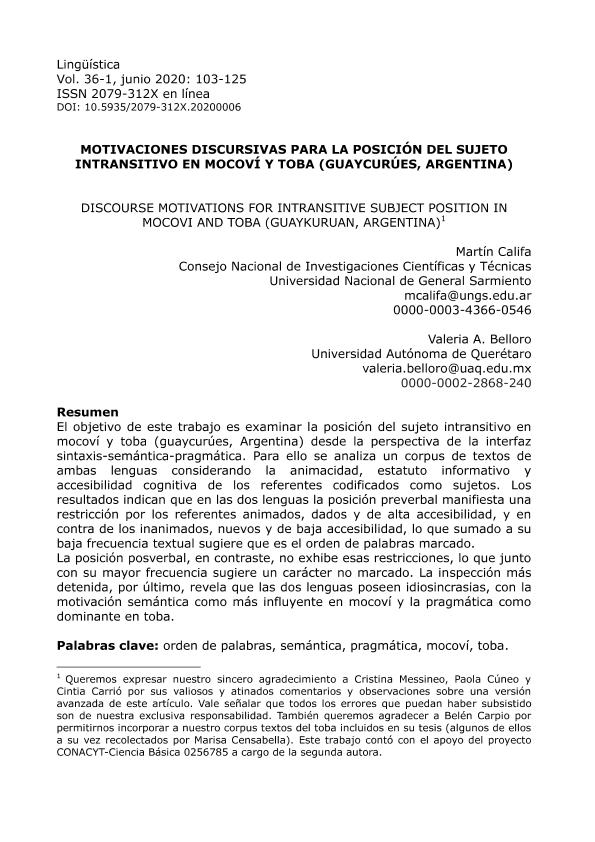Mostrar el registro sencillo del ítem
dc.contributor.author
Califa, Martín Iván

dc.contributor.author
Belloro, Valeria
dc.date.available
2022-09-20T12:19:14Z
dc.date.issued
2020-06
dc.identifier.citation
Califa, Martín Iván; Belloro, Valeria; Motivaciones discursivas para la posición de sujeto intransitivo en mocoví y toba (guaycurúes, Argentina); Asociación de Lingüística y Filología de la América Latina; Linguistica (madrid); 36; 1; 6-2020; 103-125
dc.identifier.issn
1132-0214
dc.identifier.uri
http://hdl.handle.net/11336/169486
dc.description.abstract
El objetivo de este trabajo es examinar la posición del sujeto intransitivo en mocoví y toba (guaycurúes, Argentina) desde la perspectiva de la interfaz sintaxis-semántica-pragmática. Para ello se analiza un corpus de textos de ambas lenguas considerando la animacidad, estatuto informativo y accesibilidad cognitiva de los referentes codificados como sujetos. Los resultados indican que en las dos lenguas la posición preverbal manifiesta una restricción por los referentes animados, dados y de alta accesibilidad, y en contra de los inanimados, nuevos y de baja accesibilidad, lo que sumado a su baja frecuencia textual sugiere que es el orden de palabras marcado. La posición posverbal, en contraste, no exhibe esas restricciones, lo que junto con su mayor frecuencia sugiere un carácter no marcado. La inspección más detenida, por último, revela que las dos lenguas poseen idiosincrasias, con la motivación semántica como más influyente en mocoví y la pragmática como dominante en toba.
dc.description.abstract
The aim of this paper is to examine the position of intransitive subjects in Mocovi and Toba (Guaykuruan, Argentina) from the perspective of the syntaxsemantics-pragmatics interface. To that end a text corpus from both languages is analyzed looking at the animacy, informational status, and cognitive accessibility of the referents coded as subject. The general results show that in both languages the preverbal position features a restriction favoring animate, given, and high accessibility referents, and disfavoring inanimate, new, and low accessibility ones, which coupled with its low textual frequency suggests this is the marked word order. The postverbal position, in contrast, does not show those restrictions, which along with its greater frequency suggests this is the unmarked order. Lastly, closer inspection reveals that both languages exhibit idiosyncrasies, with the semantic motivation as more influential in Mocovi, and the pragmatic motivation with a dominant role in Toba.
dc.format
application/pdf
dc.language.iso
spa
dc.publisher
Asociación de Lingüística y Filología de la América Latina
dc.rights
info:eu-repo/semantics/openAccess
dc.rights.uri
https://creativecommons.org/licenses/by-nc-sa/2.5/ar/
dc.subject
MOCOVÍ
dc.subject
TOBA
dc.subject
SINTAXIS
dc.subject
PRAGMÁTICA
dc.subject.classification
Lingüística

dc.subject.classification
Lengua y Literatura

dc.subject.classification
HUMANIDADES

dc.title
Motivaciones discursivas para la posición de sujeto intransitivo en mocoví y toba (guaycurúes, Argentina)
dc.title
Discourse motivations for intransitive subject position in mocovi and toba (Gaykuruan, Argentina)
dc.type
info:eu-repo/semantics/article
dc.type
info:ar-repo/semantics/artículo
dc.type
info:eu-repo/semantics/publishedVersion
dc.date.updated
2022-09-16T20:57:00Z
dc.journal.volume
36
dc.journal.number
1
dc.journal.pagination
103-125
dc.journal.pais
Uruguay

dc.journal.ciudad
Montevideo
dc.description.fil
Fil: Califa, Martín Iván. Universidad Nacional de General Sarmiento. Instituto del Desarrollo Humano; Argentina. Consejo Nacional de Investigaciones Científicas y Técnicas; Argentina
dc.description.fil
Fil: Belloro, Valeria. Universidad Autónoma de Querétaro; México
dc.journal.title
Linguistica (madrid)

dc.relation.alternativeid
info:eu-repo/semantics/altIdentifier/url/https://www.mundoalfal.org/es/content/ling%C3%BC%C3%ADstica-n%C2%BA-36-1
dc.relation.alternativeid
info:eu-repo/semantics/altIdentifier/doi/http://dx.doi.org/10.5935/2079 312X.20200006
dc.relation.alternativeid
info:eu-repo/semantics/altIdentifier/url/http://www.scielo.edu.uy/scielo.php?script=sci_arttext&pid=S2079-312X2020000100102
Archivos asociados
